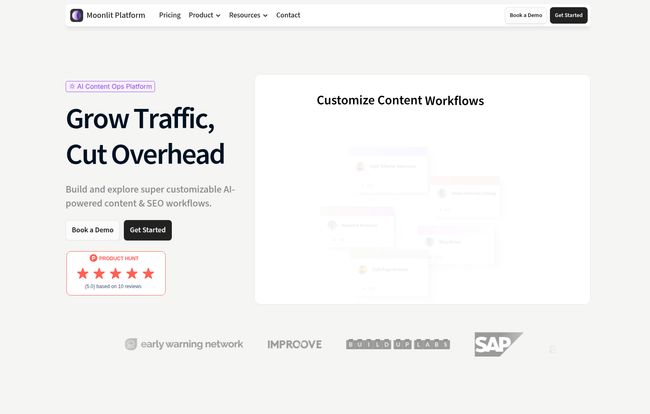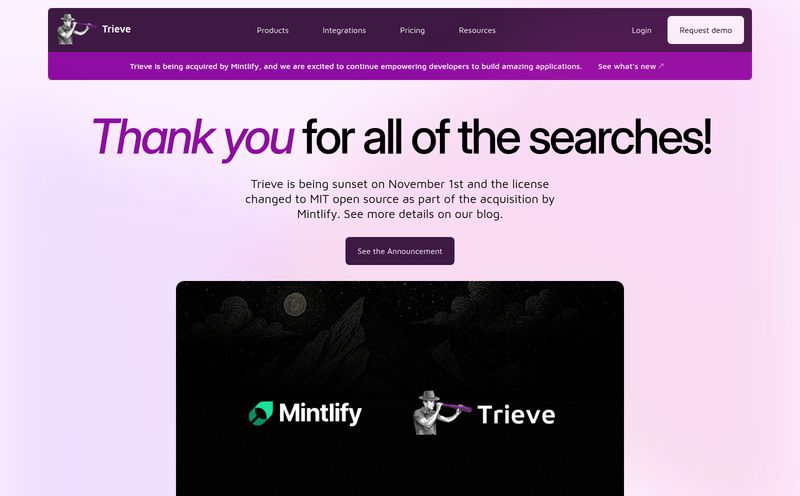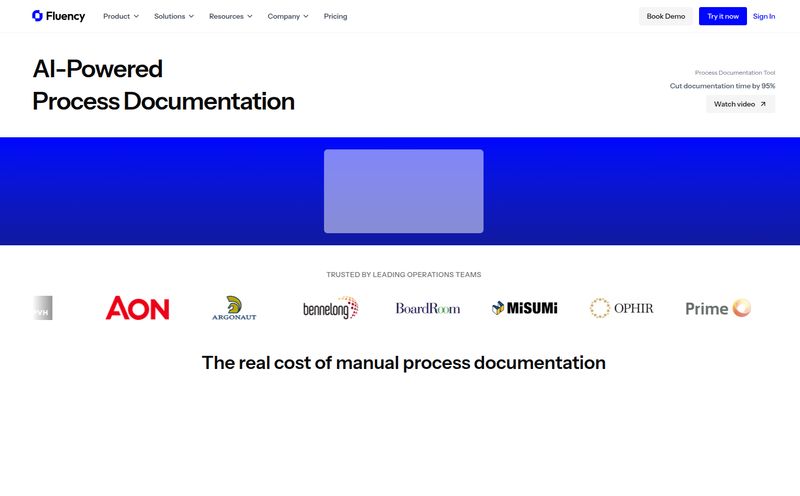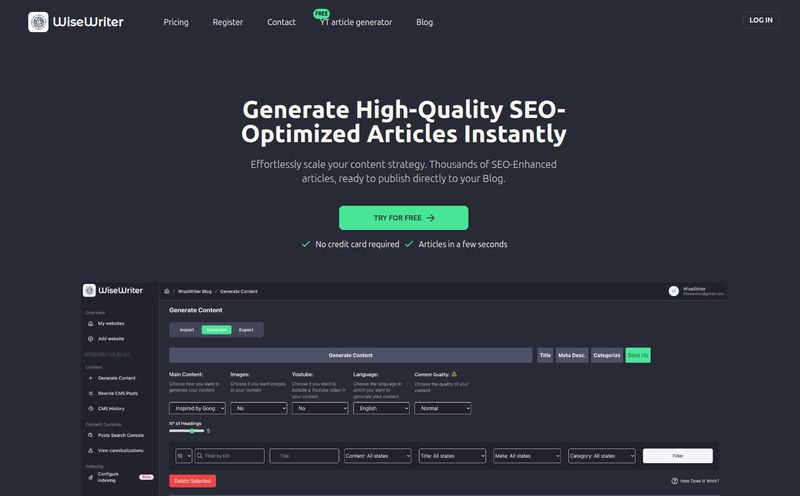As someone who's been wrestling with keywords, SERPs, and traffic trends for more years than I’d like to admit, my inbox is a constant battlefield. Every single day, a new AI tool pops up promising to be the 'next big thing' in SEO. Most of them are just shiny wrappers on the same old tech. You know the type. They give you generic, soulless content that a reader can spot from a mile away and that Google's getting smarter about every day.
So, when I first heard about Moonlit Platform, my skepticism was, shall we say, well-developed. Another AI-powered content tool? Groundbreaking. But then I looked a little closer, and the tagline wasn't about writing articles, but about building tools. That got my attention.
It’s not just another content generator. It's pitched as a builder, a workshop for creating your own, scalable AI content workflows. A way to take all those little 'I wish I had an app for that' SEO ideas and actually… make them. Without needing a degree in computer science. This felt different. So, I decided to take a look under the hood.

Visit Moonlit Platform
So What Is Moonlit Platform, Really?
Forget the idea of a simple input-output AI writer for a second. Think of Moonlit Platform less like a vending machine for articles and more like a custom LEGO set for your content strategy. It's a platform where you can orchestrate different AI models—think large language models (LLMs) like GPT, image generators, you name it—and hook them up to real-world search data. The end goal? To build your own little content-creating machines that do exactly what you need them to do, at scale.
This is for the SEO who has thought, "I just need a tool that can take a list of 100 keywords, generate unique meta descriptions in our brand voice, suggest 3 internal links for each, and then create a social media post for the top 10." With most tools, that’s a fantasy. Here, that's the whole point.
The Standout Features That Caught My Eye
When you start playing around, a few things really stand out from the typical AI crowd. It’s not just a feature list; it’s a toolkit for genuine content systemization.
The Content Workflow Editor: Your AI Command Center
This is the heart of Moonlit. It’s a visual editor where you chain together different functions. You can start with a keyword, pull in SERP data, feed that to an LLM to outline a post, send that outline to another function to write a draft, and then have another one check it for tone. It’s a bit like setting up an automations in Zapier or Make, but specifically designed for the weird and wonderful world of SEO content. It feels powerful because you're the one designing the assembly line.
Knowledge Base & Personas: Giving AI Your Brand's Brain
This, for me, is the real magic. One of the biggest fails of AI content is its generic nature. The Knowledge Base feature lets you upload your own documents, style guides, and company information. The AI can then reference this material, ensuring it talks about your products correctly and understands your internal jargon. Game. Changer.
Then there's Personas. You can train the AI on your existing blog content to learn its tone and style. No more robotic prose! You can finally get an AI assistant that sounds less like a machine and more like, well, you. It's the difference between a random freelancer and a writer who's been embedded with your team for months.
Bulk Runs: From One-Offs to an Assembly Line
Creating one perfect workflow is cool. But the real ROI in SEO comes from scale. The Bulk Runs feature lets you take a workflow you've built and run it on thousands of inputs at once. Need to generate topical maps for an entire product category? Or create unique product descriptions for a 500-item ecommerce store? You build the machine once, then let it run. This is how you stop spending 40 minutes on a repetitive task and get it done in 4.
Let's Talk Money: Moonlit Platform Pricing
Alright, the all-important question: what’s this going to cost? The pricing structure is based on a credit system, which is pretty standard for AI tools. The plans seem designed to scale with your team and your ambition.
Here’s a quick breakdown of their plans:
| Plan | Price | Key Features |
|---|---|---|
| Starter (Free) | $0 / month | 300 Credits/mo, Workflow Editor, Bulk Runs, 1MB Knowledge Base, 1 Seat. Perfect for testing the waters. |
| Pro | $30 / month | 10,000 Credits/mo, 10MB Knowledge Base, Access to Premium Functions, Logging. Great for solo operators. |
| Team (Popular) | $75 / month | 30,000 Credits/mo (Save 15%), 100MB Knowledge Base, Personas, 5 Seats. This feels like the sweet spot for small agencies. |
| Business | $200 / month | 100,000 Credits/mo (Save 33%), 1000MB Knowledge Base, 12 Seats, Early access to new features. For the serious content powerhouses. |
The free plan is genuinely useful for getting a feel for the workflow builder, which I appreciate. The credit savings on the higher tiers (Team and Business) are a nice touch, rewarding teams that go all-in. It's an investment, for sure, but when you compare it to the man-hours it could save, the math starts to look pretty compelling.
The Good, The Bad, and The Nitty-Gritty
What I Genuinely Like
The core concept is just fantastic. It empowers SEOs and content managers to be developers without writing a line of code. That testimonial about it being a "visual catalyst" is spot on. It closes the gap between a great idea and a working prototype. The potential to automate the mundane, time-sucking parts of content creation and strategy is immense, freeing up your team to focus on higher-level thinking and creativity. It’s a tool that respects the user's intelligence.
A Few Things to Keep in Mind
This isn't a one-click solution. If you're looking for a tool where you just type in a keyword and get a perfect article, this ain't it. There's a learning curve. You have to think like a systems builder. Also, you need to be mindful of your credit usage. Each step in your workflow consumes credits, and some API-based functions have a small, fixed cost on top—I believe it's around 5 credits per call. It’s not a huge deal, but something to monitor when you're running bulk tasks. This is a power tool, and with great power... well, you know the rest.
Frequently Asked Questions
What exactly are 'credits' in Moonlit Platform?
Credits are the currency you use to run tasks on the platform. Every action, like generating text with an LLM or running a function in your workflow, consumes a certain number of credits. Your monthly plan determines how many credits you get. Higher-tier plans offer a better price-per-credit.
What kind of 'Premium Functions' do you get with paid plans?
Premium Functions are more advanced, pre-built capabilities you can plug into your workflows. This could include things like connecting to real-time search data providers, advanced text analysis, or integrating with other third-party services, giving your custom tools even more power.
How does the Knowledge Base actually work?
You upload documents like your brand style guide, product spec sheets, or FAQs into your Knowledge Base. When you build a workflow, you can instruct the AI to reference this private information. This ensures the content it generates is factually accurate and consistent with your brand messaging, which is a huge step up from generic AI.
Is Moonlit Platform difficult for non-technical people to use?
It's designed to be accessible for non-technical teams. While there's a learning curve in thinking about workflows, the interface is visual and uses a drag-and-drop or simple linking style. You don't need to code. If you can map out a process on a whiteboard, you can probably build it in Moonlit.
Can I share the tools I build with my team?
Yes! The platform has comprehensive sharing options. You can build a powerful internal linking tool, for example, and then share it with your entire content team to use, ensuring everyone follows the same best practices. This is a key part of its scalability for teams.
My Final Verdict: Is Moonlit Worth Your Time?
After spending some time with it, my initial skepticism has melted away, replaced by a kind of cautious excitement. Moonlit Platform isn't for everyone. It's not for the casual blogger looking to whip up a quick post.
But for in-house SEO teams, content agencies, and strategists who are tired of being limited by off-the-shelf tools, it could be a revelation. It’s for the people who want to build a content engine, not just write an article. It gives you the power to automate your own unique strategies and scale your content production without sacrificing the authenticity and quality that's becoming so critical in the age of AI.
In my book, that's not just another tool. That’s a competitive advantage.



